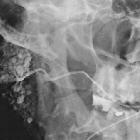BALT Lymphoma

BALT lymphoma is an abbreviated term for bronchus-associated lymphoid tissue lymphoma. These neoplasms fall under the broader umbrella of mucosa associated lymphoid tissue (MALT) lymphomas. It is sometimes considered a type of primary pulmonary lymphoma.
Clinical presentation
Up to half of patients can be asymptomatic and tumors are often discovered incidentally.
Pathology
BALT lymphoma represents a low-grade B-lymphocyte lymphoma composed of monotonous small lymphocytes with focal plasmacytoid features. They are composed of subepithelial lymphoid follicles distributed along distal bronchi and bronchioles.
Associations
The tumors can have a number of associations which include :
- Sjögren syndrome
- dysgammaglobulinemia
- amyloid deposition
- collagen vascular disease
- Helicobacter pylori infection
- AIDS
Radiographic features
CT
Appearances can be quite variable. Described features include:
- solitary, well-delineated soft-tissue masses - most BALT lymphoma cases
- less common imaging features include
- multiple unilateral or bilateral nodules
- diffuse infiltrates along bronchovascular bundles and interlobular septa
- extensive lobar infiltrates mimicking consolidation (pneumonia) with air bronchograms or areas of ground-glass attenuation
- bubble-like radiolucencies
- hilar and mediastinal lymphadenopathy: not a prominent radiologic finding with nodal involvement present at pathologic analysis in 30% of cases
Treatment and prognosis
Most tend to be slow-growing lesions. The disease is often localized at the time of diagnosis and responds favourably to treatment.
Siehe auch:
- Bronchopneumogramm
- Milchglasverschattungen
- Sjögren-Syndrom
- Lymphom pulmonale Manifestation
- MALT
- AIDS
- consolidation
- primäres pulmonales Lymphom
und weiter:

 Assoziationen und Differentialdiagnosen zu bronchus associated lymphoid tissue lymphoma:
Assoziationen und Differentialdiagnosen zu bronchus associated lymphoid tissue lymphoma:




